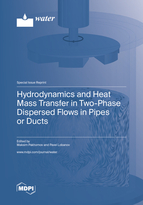Hydrodynamics and Heat Mass Transfer in Two-Phase Dispersed Flows in Pipes or Ducts
A special issue of Water (ISSN 2073-4441). This special issue belongs to the section "Hydraulics and Hydrodynamics".
Deadline for manuscript submissions: closed (1 December 2022) | Viewed by 18328
Special Issue Editors
Interests: numerical simulation; fluid mechanics; computational fluid dynamics; CFD simulation; heat and mass transfer; numerical modelling; thermal engineering; modelling and simulation; mechanical engineering; engineering; turbulent two-phase flows; droplets; bubbles
Special Issues, Collections and Topics in MDPI journals
Interests: measurements and experiments; turbulent flows; heat and mass transfer; engineering; nuclear thermal hydraulics; mechanical engineering
Special Issues, Collections and Topics in MDPI journals
Special Issue Information
Dear Colleagues,
Two-phase gas–liquid flows are frequently encountered in energy, nuclear, chemical, geothermal, oil and gas, and refrigeration industries. Two-phase gas–liquid flows can occur in various forms, such as flows transitioning from pure liquid to vapor as a result of external heating; separated flows behind a sudden flow expansion or constriction, and dispersed two-phase flows where dispersed phase is present in the form of liquid droplets or gas bubbles in a continuous carrier fluid phase (i.e., gas or liquid). Typically, such flows are turbulent with a considerable interfacial interaction between the carrier fluid and the dispersed phases. The interfacial heat and mass transfer is very important in the modeling of such flows. The variety of flow regimes significantly complicates the theoretical prediction of hydrodynamics in the two-phase flow. Thus, the application of numerous hypotheses, assumptions, and approximations is required. The complexity of flow structure often makes it impossible to theoretically describe its behavior, and so empirical data are applied instead. The correct simulation of two-phase gas–liquid flows is of great importance for the safety and prediction of energy equipment elements.
Sincerely yours,
Prof. Dr. Maksim Pakhomov
Dr. Pavel Lobanov
Guest Editors
Manuscript Submission Information
Manuscripts should be submitted online at www.mdpi.com by registering and logging in to this website. Once you are registered, click here to go to the submission form. Manuscripts can be submitted until the deadline. All submissions that pass pre-check are peer-reviewed. Accepted papers will be published continuously in the journal (as soon as accepted) and will be listed together on the special issue website. Research articles, review articles as well as short communications are invited. For planned papers, a title and short abstract (about 100 words) can be sent to the Editorial Office for announcement on this website.
Submitted manuscripts should not have been published previously, nor be under consideration for publication elsewhere (except conference proceedings papers). All manuscripts are thoroughly refereed through a single-blind peer-review process. A guide for authors and other relevant information for submission of manuscripts is available on the Instructions for Authors page. Water is an international peer-reviewed open access semimonthly journal published by MDPI.
Please visit the Instructions for Authors page before submitting a manuscript. The Article Processing Charge (APC) for publication in this open access journal is 2600 CHF (Swiss Francs). Submitted papers should be well formatted and use good English. Authors may use MDPI's English editing service prior to publication or during author revisions.
Keywords
- two-phase dispersed flow
- liquid droplets
- gas bubbles
- flow structure
- heat and mass transfer
- measurements
- numerical modeling







